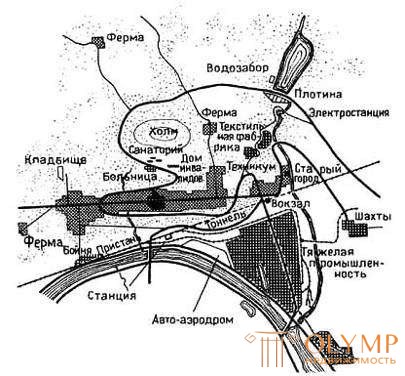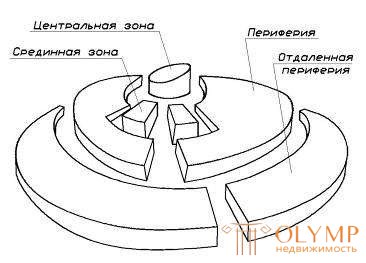
Definition: functional zoning - differentiation of the city territories by the nature of its use.
The division of the city into distinct functional areas was not always characteristic of the city, in pre-industrial cities one can observe spatial combination of functions. The emergence of a new principle of organizing a city (functional zoning) is associated with the industrial revolution in Europe.
For the first time, the principle of functional zoning was formulated by T. Garnier in 1903. The novelty consisted in a clear distinction between functions and processes in the city and, as a result, in new methods of organizing living space and transport and pedestrian traffic. Garnier proposed spatially separate: housing, labor, recreation, training, movement (Fig.
75).

Gradually, the principle of functional zoning conquers the minds of professional architects and is adopted by town-planning theory and practice (Fig. 76).

Fig. 76. Functional-flow linear development scheme, N. Milyutin
A significant contribution to the theoretical development and popularization of functional zoning ideas was made by CIAM (International Congress of Modern Architecture):
• 1928 CIAM Congress, excerpt from the declaration: "... Urban planning - the organization of the functions of collective life ...".
• 1933 CIAM Congress - the adoption of the Athens Charter, an excerpt from the declaration: "... Functional zoning is the main principle of urban planning ...".
The principle of functional zoning implies the reduction of the whole diversity of processes occurring in the city to the following generalized scheme (Fig. 77):

Fig. 77
Currently, the principle of functional zoning is enshrined in urban planning legislation and is used in urban planning practice.
Definition: Functional areas - areas for which territorial planning documents define boundaries and functional purpose.
Main functional areas
• residential (occupies about 50% of the city, in the residential area can be identified residential and public-business areas);
• industrial;
• warehouse;
• communal;
• zone of engineering and transport infrastructure; recreational.
At the end of the twentieth century. The principle of functional zoning is criticized by specialists because of the inability to reflect the complexity of interactions within a city. Such criticism is due both to the elementary nature of the “work-life-rest” formula and the processes occurring in cities: the shift in the labor balance, the integration and the emergence of new functions, the development of the city vertically (vertical zoning), etc.
In addition, the functional model of the city does not take into account the distance (accessibility) from the city center, the building density, the intensity of the processes occurring on its territory, the quality of the urban environment, investment attractiveness, etc. (Fig. 79).
|
|
|
Fig. 79 Assessment of residents of the territory of Lviv. | Fig. 79 Estimated value of land plots of Novosibirsk. | Fig. 79 Heterogeneity of the city San Francisco. |
To overcome these shortcomings, the principle (model) of zone zoning has been proposed, which is intended to complement the functional view of the development of the city.
Belt Zoning
Definition: zone zoning - zoning according to the intensity of the use of territories, the degree of saturation with its various functions (Fig. 79).
The central zone is the most multifunctional element with a high concentration of various functions, the focus of public life in the city, the most intensively developed territory with high urban value.
The periphery - the territory of the city, which is characterized by the lowest density and narrow set of functions, communication with the center is difficult (distance, natural or artificial barriers), the least intensively developed, with low urban value.
The middle zone is the density of functions and the intensity of development is less than in the central zone, but more than in the periphery.
Remote periphery - the minimum set of functions (suburban areas).

Fig. 79
As the city develops (territorial expansion or reconstruction), the zones of the belt zones are transformed. The change in the configuration of the borders of the belt zones is directly affected by the development of the planning structure (frame) of the city. The zone zones expand, absorbing each other (the central zone expands at the expense of the middle one, the middle one at the expense of the periphery, etc.).
Что бы оставить комментарий войдите
Комментарии (0)